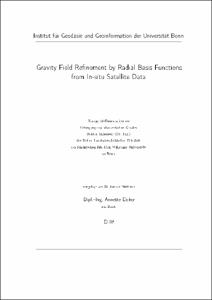Eicker, Annette: Gravity Field Refinement by Radial Basis Functions from In-situ Satellite Data. - Bonn, 2008. - Dissertation, Rheinische Friedrich-Wilhelms-Universität Bonn.
Online-Ausgabe in bonndoc: https://nbn-resolving.org/urn:nbn:de:hbz:5N-13754
Online-Ausgabe in bonndoc: https://nbn-resolving.org/urn:nbn:de:hbz:5N-13754
@phdthesis{handle:20.500.11811/3245,
urn: https://nbn-resolving.org/urn:nbn:de:hbz:5N-13754,
author = {{Annette Eicker}},
title = {Gravity Field Refinement by Radial Basis Functions from In-situ Satellite Data},
school = {Rheinische Friedrich-Wilhelms-Universität Bonn},
year = 2008,
note = {In this thesis, an integrated approach is developed for the regional refinement of global gravity field solutions. The analysis concepts are tailored to the in-situ type character of the observations provided by the new satellite missions CHAMP, GRACE, and GOCE. They are able to evaluate data derived from short arcs of the satellite's orbit and, therefore, offer the opportunity to use regional satellite data for the calculation of regional gravity field solutions. The regional character of the approach will be realized at various stages of the analysis procedure. The first step is the design of specifically tailored space localizing basis functions. In order to adapt the basis functions to the signal content to be expected in the gravity field solution, they will be derived from the covariance function of the gravitational potential. To use the basis functions in gravity field modeling, they have to be located at the nodal points of a spherical grid; therefore investigations will be performed regarding a suitable choice of such a nodal point distribution. Another important aspect in the regional gravity field analysis approach is the downward continuation process. In this context, a regionally adapted regularization will be introduced which assigns different regularization matrices to geographical areas with varying signal content. Regularization parameters individually determined for each region take into account the varying frequency behavior, allowing to extract additional information out of a given data set. To conclude the analysis chain, an approach will be described that combines regional solutions with global coverage to obtain a global solution and to derive the corresponding spherical harmonic coefficients by means of the Gauss-Legendre quadrature method. The capability of the method will be demonstrated by its successful application to real data provided by CHAMP and GRACE and to a simulation scenario based on a combination of GRACE and GOCE observations.},
url = {https://hdl.handle.net/20.500.11811/3245}
}
urn: https://nbn-resolving.org/urn:nbn:de:hbz:5N-13754,
author = {{Annette Eicker}},
title = {Gravity Field Refinement by Radial Basis Functions from In-situ Satellite Data},
school = {Rheinische Friedrich-Wilhelms-Universität Bonn},
year = 2008,
note = {In this thesis, an integrated approach is developed for the regional refinement of global gravity field solutions. The analysis concepts are tailored to the in-situ type character of the observations provided by the new satellite missions CHAMP, GRACE, and GOCE. They are able to evaluate data derived from short arcs of the satellite's orbit and, therefore, offer the opportunity to use regional satellite data for the calculation of regional gravity field solutions. The regional character of the approach will be realized at various stages of the analysis procedure. The first step is the design of specifically tailored space localizing basis functions. In order to adapt the basis functions to the signal content to be expected in the gravity field solution, they will be derived from the covariance function of the gravitational potential. To use the basis functions in gravity field modeling, they have to be located at the nodal points of a spherical grid; therefore investigations will be performed regarding a suitable choice of such a nodal point distribution. Another important aspect in the regional gravity field analysis approach is the downward continuation process. In this context, a regionally adapted regularization will be introduced which assigns different regularization matrices to geographical areas with varying signal content. Regularization parameters individually determined for each region take into account the varying frequency behavior, allowing to extract additional information out of a given data set. To conclude the analysis chain, an approach will be described that combines regional solutions with global coverage to obtain a global solution and to derive the corresponding spherical harmonic coefficients by means of the Gauss-Legendre quadrature method. The capability of the method will be demonstrated by its successful application to real data provided by CHAMP and GRACE and to a simulation scenario based on a combination of GRACE and GOCE observations.},
url = {https://hdl.handle.net/20.500.11811/3245}
}






